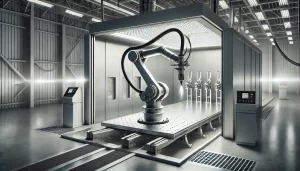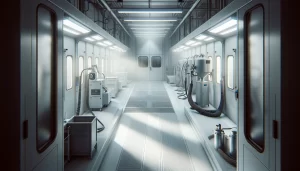A sandblasting booth is one of the most powerful tools for surface preparation, but keeping it clean is essential for efficiency, safety, and equipment longevity. Without regular cleaning, dust and abrasive materials can accumulate, affecting visibility, air quality, and overall performance. Whether you’re using a sandblasting booth for industrial applications, automotive refinishing, or metal fabrication, a proper cleaning routine will help maintain optimal working conditions.
Cleaning a sandblasting booth may seem like a daunting task, but with the right approach, it can be done efficiently. A systematic process ensures that all residual dust, spent abrasive media, and contaminants are removed without damaging the booth’s components. If you’ve ever wondered about the best way to keep your sandblasting booth in top shape, this guide will walk you through the process step by step.
Why Regular Cleaning is Important
In a sandblasting environment, dust and debris are unavoidable. The abrasive media breaks down over time, creating fine particles that can linger in the air and settle on surfaces. If these particles aren’t cleaned regularly, they can cause various problems.
First, excessive dust buildup can clog ventilation and filtration systems, reducing the booth’s ability to maintain proper airflow. Poor air circulation affects the efficiency of the blasting process and increases the risk of dust escaping into surrounding work areas. Additionally, dust and abrasive residue can settle on equipment, reducing its lifespan and leading to costly repairs.
Safety is another major concern. Fine particles in the air can pose respiratory hazards to workers if inhaled, even with protective gear. Slippery floors from excessive dust accumulation also increase the risk of workplace accidents. Keeping the booth clean helps ensure a safer and more productive work environment.
Steps to Properly Clean a Sandblasting Booth
Cleaning a sandblasting booth requires attention to detail and the right tools. The process involves removing spent media, clearing dust, maintaining ventilation systems, and inspecting key components.
1. Turn Off the Equipment and Ensure Proper Ventilation
Before starting any cleaning work, turn off all equipment inside the booth. This includes the blasting system, ventilation fans, and dust collectors. Proper ventilation is crucial, so if your booth has an exhaust system, let it run for a few minutes to clear excess dust before shutting it down completely.
If your booth does not have an automatic ventilation system, consider using portable air movers or opening access doors to allow airborne particles to settle before proceeding.
2. Remove Spent Abrasive Media
Over time, the blasting media accumulates on the booth floor. Depending on your system, you may have a reclaim system that collects and recycles the media, but even with reclaim systems, some spent media needs to be manually removed.
Use a shovel or a vacuum designed for abrasive materials to remove spent media from the floor and corners of the booth. Avoid sweeping with a regular broom, as it can stir up fine dust particles, making the air quality worse. If using a vacuum, ensure that it is rated for fine particulate collection to prevent dust from being recirculated into the air.
3. Clean Walls and Ceilings
Dust and abrasive particles often settle on the walls and ceiling of the booth, gradually reducing visibility and contaminating new projects. Use a soft-bristled brush or compressed air to loosen any dust from the walls and overhead areas. A vacuum with a HEPA filter can be effective for capturing airborne particles as you work.
For stubborn buildup, a damp cloth can be used to wipe down surfaces, but avoid excessive moisture as it can cause abrasive residue to clump and become harder to remove later.
4. Maintain the Ventilation and Filtration System
The ventilation system is critical for keeping the sandblasting booth clean and ensuring proper air circulation. Over time, dust collectors and air filters become clogged, reducing efficiency.
Check and replace air filters regularly according to the manufacturer’s guidelines. If the dust collector has a built-in cleaning function, activate it to remove excess dust from the filters. In some cases, filters may need to be manually cleaned with compressed air or replaced entirely if they are too clogged.
Inspect the ductwork and exhaust system for any blockages. Accumulated dust in the vents can restrict airflow, leading to poor performance. If necessary, use an industrial vacuum to clean out the ventilation pathways.
5. Inspect and Maintain Equipment
While cleaning the booth, take the opportunity to inspect essential components such as blast nozzles, hoses, and lighting fixtures. Dust buildup on light fixtures can reduce visibility inside the booth, making it harder to achieve precision during blasting.
Check hoses and nozzles for wear and tear. Abrasive media can gradually erode these components, leading to reduced performance and uneven blasting results. Replace any worn-out parts as needed to keep your system running smoothly.
6. Clean the Floor and Work Area
Once the majority of dust and spent media has been removed, do a final pass on the floor. If your booth has a grated floor with a media recovery system, ensure that it is functioning properly and free from blockages.
For manual cleanup, use a vacuum or dust suppression system to collect any remaining particles. If necessary, mop the floor with a damp mop to capture fine dust that might have settled. Again, avoid excessive moisture, as it can cause dust to harden and become difficult to remove.
Best Practices for Keeping Your Sandblasting Booth Clean
Regular cleaning is the key to maintaining a sandblasting booth in optimal condition. To make the process more manageable, consider implementing a routine maintenance schedule.
- Daily Maintenance: Perform a quick visual inspection, remove any large debris, and check ventilation performance.
- Weekly Cleaning: Clear out spent media, wipe down walls and surfaces, and inspect air filters.
- Monthly Deep Clean: Conduct a thorough cleaning, replace filters if needed, and check all equipment for wear and tear.
Using high-quality, durable abrasives can also help reduce dust generation and extend the lifespan of your booth’s components. Additionally, investing in an effective dust collection system will significantly improve air quality and minimize cleaning time.
Conclusion
A clean sandblasting booth is essential for efficiency, safety, and equipment longevity. While the cleaning process requires effort, it pays off in the long run by ensuring consistent performance and reducing costly repairs. By incorporating a regular cleaning routine, maintaining proper ventilation, and inspecting key components, you can keep your sandblasting booth in top condition.
Whether you operate a small shop or a large industrial facility, cleanliness should be a priority in any sandblasting environment. A well-maintained booth not only improves the quality of your work but also creates a safer workspace for operators. Keeping up with these cleaning practices will help you get the most out of your sandblasting equipment while ensuring a smooth and efficient operation.
Specialized Sandblasting Booth Services
We specialize in providing top-quality sandblasting booths and custom finishing solutions tailored to meet the unique needs of various industries. Our expert team designs and manufactures state-of-the-art sandblasting booths that ensure safety, efficiency, and superior performance. From automotive and aerospace to marine and industrial applications, our booths are engineered to handle even the most demanding surface preparation tasks. We offer comprehensive services, including booth installation, maintenance, upgrades, and technical support.




